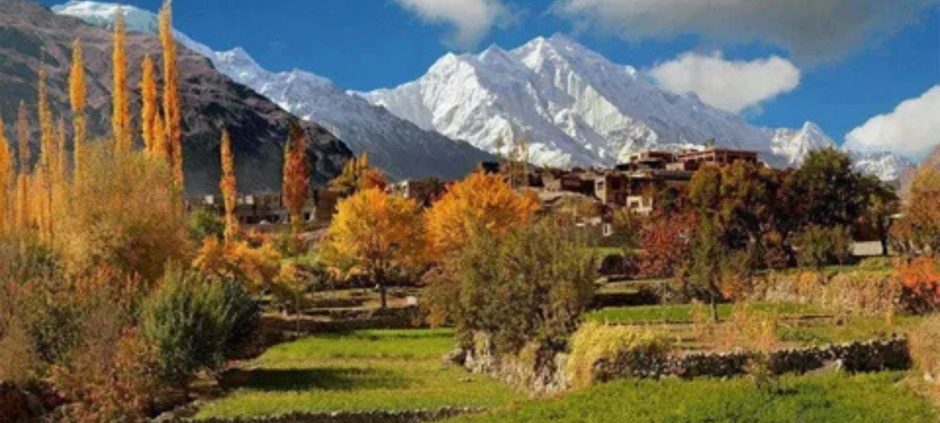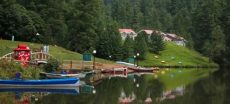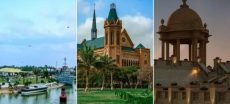Imagine sipping your morning chai while mountains around you shift colors, pink cherry blossoms in spring, fiery gold in autumn, and a snowy silence in winter. That’s Hunza weather for you: unpredictable, poetic, and full of surprises. Whether you’re planning a quick visit or dreaming of staying there for a month working remotely, understanding Hunza’s climate is your first step.
Seasonal Guide to Hunza Weather
Here’s how Hunza’s weather changes throughout the year, when to go for blossoms, when to chase snow, and when to bask in autumn’s glow.
Blossom Season & Mild Days
Spring in Hunza is pure magic. From March to May, the valley warms up slowly, with daytime temperatures ranging from 10°C to 20°C.
The famous cherry and apricot blossoms usually bloom in April, turning valleys pink and white. Nights are still cool, often dipping to around 0–10°C. It’s the perfect season for photography, nature walks, and soaking in local culture.
This is a sweet spot for travelers: fewer crowds than summer, and a soft, floral energy in the air.
Green & Adventure-Ready
Summer brings mild, pleasant weather, and day temperatures in Hunza go from 20°C to 25°C.
Nights are cooler, thanks to the altitude, so you often need a light jacket. It’s the peak time for trekking, boating on Attabad Lake, and exploring mountain trails.
Fruit orchards (cherries, apricots, apples) are in full swing, making summer also about discovering Hunza’s flavors. If you love outdoor adventures and don’t mind moderate tourist traffic, summer is ideal.
Golden & Quiet
Autumn in Hunza feels like a dream. From September to November, daytime temps hover between 10°C and 20°C.
The valley transforms into a canvas of red, amber, and yellow as leaves change color. Nights grow chilly (0–10°C), but days remain crisp and clear.
This is one of the most photogenic times to visit, perfect for slow travel, romantic getaways, or just unwinding in nature. The skies are often clear, and the beauty feels more private because the peak tourist rush of summer has passed.
Snow, Silence & Reflection
Winter is where Hunza shows its quiet, powerful side. Temperatures can drop below freezing, especially at night.
Higher villages often receive heavy snow, turning valleys and peaks into a white wonderland. Roads to remote areas can become difficult or even blocked. For travelers, it’s a season of calm reflection, cozy homestays, snow treks, and fireplaces.
Just know: winter in Hunza isn’t just Instagram‑pretty, it’s also demanding. Warm clothes, good planning, and a willingness to slow down go a long way.
Remote Work in Hunza
If you’re eyeing Hunza as a remote work destination, here’s what real digital nomads say about working and living for a month in the valley.
Internet, coworking & connectivity
- KADO Digital Hub is the go-to coworking spot in Hunza. One remote worker shared: “You can work from Hunza … Private space + fibre‑level internet → 17k–20k per month.”
- There are fiber connections, but be ready for occasional downtime: “There are a few co‑working spaces … fibre internet … minus the downtime due to fibre cuts along KKH.”
- As backup, many use SCom or Telenor SIMs. According to a Redditor: “I had to use SCom sim … when the fibre died.”
Cost of living for a month
Let’s break it down,
- Accommodation:
- Guesthouses: ~ Rs 25,000–35,000/month
- Hotels / Airbnb: ~ Rs 75,000–90,000/month
- Food: ~ Rs 30,000–45,000 for a month if you eat modestly.
- Coworking / Work Hub: ~ Rs 17,000–20,000/month for KADO Hub.
- Extras (treks, local travel): Around Rs 10,000–20,000, depending on how adventurous you get.
So overall, a modest remote-working setup in Hunza can cost around Rs 70,000–80,000 a month. If you pick comfortable lodging and explore more, it could go up to Rs 120,000–150,000.
Living rhythm & local life
- Weather plays a big role: “Weather has mood swings. Respect it.”
- Hiring local guides is wise: they help you avoid getting lost on mountain routes. Locals are kind and deeply rooted in their culture: “Respect the valley … set boundaries, keep it clean, waste less … try to give something back.”
- Power and electricity: A traveler mentioned UPS backup, but in winter, it can be limited: “Electric heater … you can only use according to WAPDA schedule … maybe one or two hours a day.”
Weather & Remote Work: Smart Timing Tips
If you’re planning to work remotely in Hunza, here’s when you should go:
- Spring (Mar–May): Mild weather & blossoms means peaceful mornings, creative energy.
- Autumn (Sep–Nov): Beautiful foliage, fewer tourists, crisp days, great for weekend hikes.
- Avoid deep winter unless you’re prepared: power issues & heavy snow can make working tricky.
- Summer is fine, especially for those who don’t mind more people, but pick your lodging wisely for good internet.
Takeaway
Hunza weather is a story in itself, one that changes its chapter every few months. Whether you visit for the cherry blossoms, walk under golden autumn skies, or spend a month working amid mountain calm, the valley has something magical to offer.
If you’re planning a remote trip or a seasonal escape, check out this in-depth Hunza food & travel guide to make your experience even richer.
So, ready to make Hunza your work‑cation destination? Pack your layers, bring your laptop, and let Hunza’s rhythms inspire you from morning to mountain dusk.










